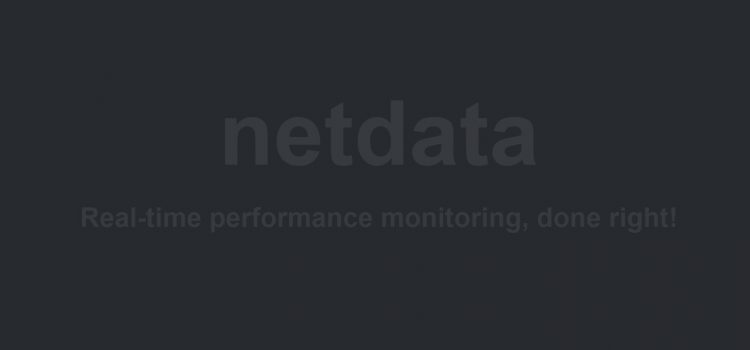Real-time Performance Monitoring, Done Right! Netdata
Netdata is distributed, real-time performance and health monitoring for systems and applications. It is a highly-optimized monitoring agent you install on all your systems and containers.
Netdata provides unparalleled insights, in real-time, of everything happening on the systems it’s running on (including web servers, databases, applications), using highly interactive web dashboards.
A highly-efficient database stores long-term historical metrics for days, weeks, or months, all at 1-second granularity. Run this long-term storage autonomously, or integrate Netdata with your existing monitoring toolchains (Prometheus, Graphite, OpenTSDB, Kafka, Grafana, and more).
Netdata is fast and efficient, designed to permanently run on all systems (physical and virtual servers, containers, IoT devices), without disrupting their core function.
Netdata is free, open-source software and it currently runs on Linux, FreeBSD, and macOS, along with other systems derived from them, such as Kubernetes and Docker.
What does it look like?
The following animated GIF shows the top part of a typical Netdata dashboard.
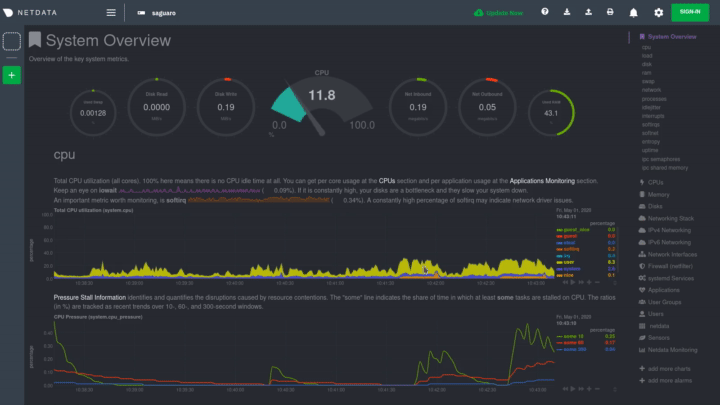
SHIFT + mouse wheel, an area can be selected for zoom-in with SHIFT + mouse selection. Netdata is highly interactive, real-time, and optimized to get the work done!See the live demo
Why Netdata
Netdata has a quite different approach to monitoring.
Netdata is a monitoring agent you install on all your systems. It is:
- A metrics collector for system and application metrics (including web servers, databases, containers, and much more),
- A long-term metrics database that stores recent metrics in memory and “spills” historical metrics to disk for efficient long-term storage,
- A super fast, interactive, and modern metrics visualizer optimized for anomaly detection,
- And an alarms notification engine for detecting performance and availability issues.
All the above, are packaged together in a very flexible, extremely modular, distributed application.
This is how Netdata compares to other monitoring solutions:
| Netdata | others (open-source and commercial) |
|---|---|
| High resolution metrics (1s granularity) | Low resolution metrics (10s granularity at best) |
| Monitors everything, thousands of metrics per node | Monitor just a few metrics |
| UI is super fast, optimized for anomaly detection | UI is good for just an abstract view |
| Long-term, autonomous storage at one-second granularity | Centralized metrics in an expensive data lake at 10s granularity |
| Meaningful presentation, to help you understand the metrics | You have to know the metrics before you start |
| Install and get results immediately | Long preparation is required to get any useful results |
| Use it for troubleshooting performance problems | Use them to get statistics of past performance |
| Kills the console for tracing performance issues | The console is always required for troubleshooting |
| Requires zero dedicated resources | Require large dedicated resources |
Netdata is open-source, free, super fast, very easy, completely open, extremely efficient, flexible and integrate-able.
It has been designed by system administrators, DevOps engineers, and developers for to not just visualize metrics, but also troubleshoot complex performance problems.
Features
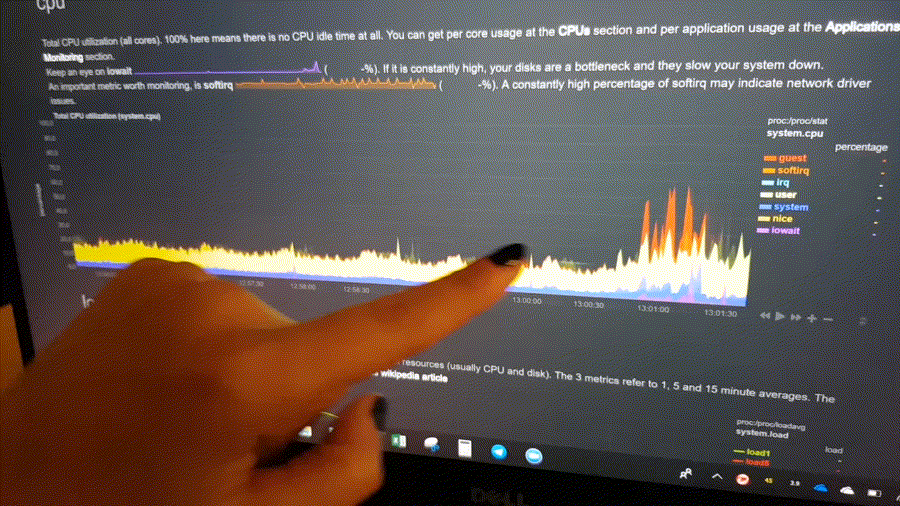
This is what you should expect from Netdata:
General
- 1s granularity – The highest possible resolution for all metrics.
- Unlimited metrics – Netdata collects all the available metrics—the more, the better.
- 1% CPU utilization of a single core – It’s unbelievably optimized.
- A few MB of RAM – The highly-efficient database engine stores per-second metrics in RAM and then “spills” historical metrics to disk long-term storage.
- Minimal disk I/O – While running, Netdata only writes historical metrics and reads
errorandaccesslogs. - Zero configuration – Netdata auto-detects everything, and can collect up to 10,000 metrics per server out of the box.
- Zero maintenance – You just run it. Netdata does the rest.
- Zero dependencies – Netdata runs a custom web server for its static web files and its web API (though its plugins may require additional libraries, depending on the applications monitored).
- Scales to infinity – You can install it on all your servers, containers, VMs, and IoT devices. Metrics are not centralized by default, so there is no limit.
- Several operating modes – Autonomous host monitoring (the default), headless data collector, forwarding proxy, store and forward proxy, central multi-host monitoring, in all possible configurations. Each node may have different metrics retention policies and run with or without health monitoring.
Health Monitoring & Alarms
- Sophisticated alerting – Netdata comes with hundreds of alarms out of the box! It supports dynamic thresholds, hysteresis, alarm templates, multiple role-based notification methods, and more.
- Notifications: alerta.io, amazon sns, discordapp.com, email, flock.com, hangouts, irc, kavenegar.com, messagebird.com, pagerduty.com, prowl, pushbullet.com, pushover.net, rocket.chat, slack.com, smstools3, syslog, telegram.org, twilio.com, web and custom notifications.
Integrations
- Time-series databases – Netdata can archive its metrics to Graphite, OpenTSDB, Prometheus, AWS Kinesis, MongoDB, JSON document DBs, in the same or lower resolution (lower: to prevent it from congesting these servers due to the amount of data collected). Netdata also supports Prometheus remote write API, which allows storing metrics to Elasticsearch, Gnocchi, InfluxDB, Kafka, PostgreSQL/TimescaleDB, Splunk, VictoriaMetrics and a lot of other storage providers.
Visualization
- Stunning interactive dashboards – the dashboard is mouse-, touchpad-, and touch-screen friendly in 2 themes:
slate(dark) andwhite. - Amazingly fast visualization – Even on low-end hardware, the dashboard responds to all queries in less than 1 ms per metric.
- Visual anomaly detection – UI/UX emphasizes the relationships between charts so you can better detect anomalies visually.
- Embeddable – Charts can be embedded on your web pages, wikis and blogs. You can even use Atlassian’s Confluence as a monitoring dashboard.
- Customizable – You can build custom dashboards using simple HTML. No JavaScript needed!
Positive and negative values
To improve clarity on charts, Netdata dashboards present positive values for metrics representing read, input, inbound, received and negative values for metrics representing write, output, outbound, sent.

Netdata charts showing the bandwidth and packets of a network interface. received is positive and sent is negative.
Autoscaled y-axis
Netdata charts automatically zoom vertically, to visualize the variation of each metric within the visible time-frame.

A zero-based stacked chart, automatically switches to an auto-scaled area chart when a single dimension is selected.
Charts are synchronized
Charts on Netdata dashboards are synchronized to each other. There is no master chart. Any chart can be panned or zoomed at any time, and all other charts will follow.
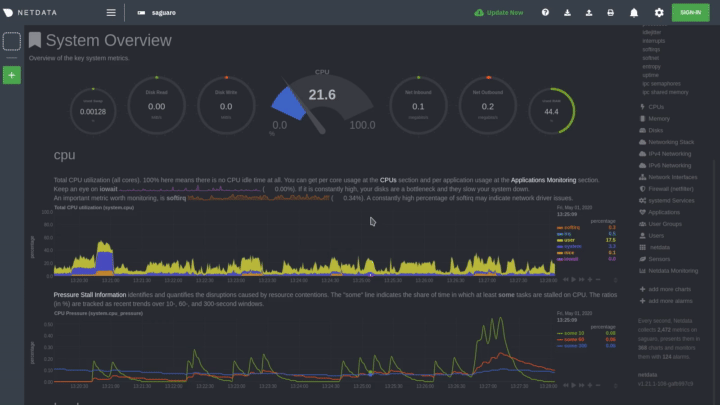
Charts are panned by dragging them with the mouse. Charts can be zoomed in/out with SHIFT + mouse wheel while the mouse pointer is over a chart.
Highlighted time-frame
To improve visual anomaly detection across charts, the user can highlight a time-frame (by pressing Alt + mouse selection) on all charts.
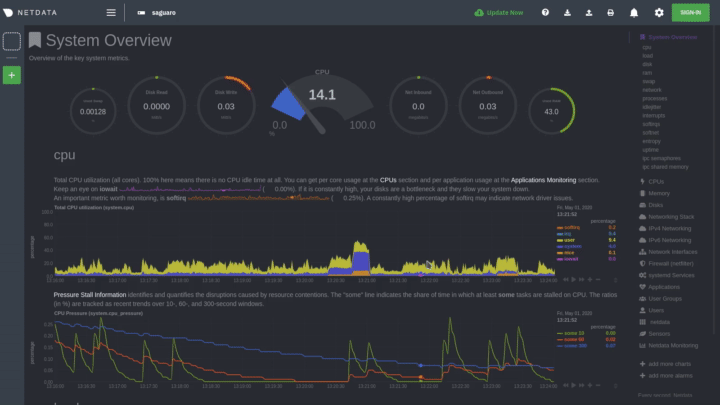
A highlighted time-frame can be given by pressing Alt + mouse selection on any chart. Netdata will highlight the same range on all charts.
What Netdata monitors
Netdata can collect metrics from 200+ popular services and applications, on top of dozens of system-related metrics jocs, such as CPU, memory, disks, filesystems, networking, and more. We call these collectors, and they’re managed by plugins, which support a variety of programming languages, including Go and Python.
Popular collectors include Nginx, Apache, MySQL, statsd, cgroups (containers, Docker, Kubernetes, LXC, and more), Traefik, web server access.log files, and much more.
See the full list of supported collectors.
Netdata’s data collection is extensible, which means you can monitor anything you can get a metric for. You can even write a collector for your custom application using their plugin API.
Quickstart
To install Netdata from source on any Linux system (physical, virtual, container, IoT, edge), including all dependencies required to connect to Netdata Cloud, and get automatic nightly updates, run the following as your normal user:
# make sure you run `bash` for your shell
bash
# install Netdata directly from GitHub source
bash <(curl -Ss https://my-netdata.io/kickstart.sh)Starting with v1.12, Netdata collects anonymous usage information by default and sends it to Google Analytics. Read about the information collected, and learn how to-opt, on the anonymous statistics page.
The usage statistics are vital for us, as we use them to discover bugs and prioritize new features. We thank you for actively contributing to Netdata’s future.
To learn more about the pros and cons of using nightly vs. stable releases, see the notice about the two options.
The above command will:
- Install any required packages on your system (it will ask you to confirm before doing so)
- Compile it, install it, and start it.
More installation methods and additional options can be found at the installation page.
To try Netdata in a Docker container, run this:
docker run -d --name=netdata \
-p 19999:19999 \
-v netdatalib:/var/lib/netdata \
-v netdatacache:/var/cache/netdata \
-v /etc/passwd:/host/etc/passwd:ro \
-v /etc/group:/host/etc/group:ro \
-v /proc:/host/proc:ro \
-v /sys:/host/sys:ro \
-v /etc/os-release:/host/etc/os-release:ro \
--restart unless-stopped \
--cap-add SYS_PTRACE \
--security-opt apparmor=unconfined \
netdata/netdataFor more information about running Netdata in Docker, check the docker installation page.

From Netdata v1.12 and above, anonymous usage information is collected by default and sent to Google Analytics. To read more about the information collected and how to opt-out, check the anonymous statistics page.
That’s it!
Now you’re ready to monitor your metrics in real time with Netdata dashboards. If you want the best professionals to take care of your server don’t hesitate to contact us
